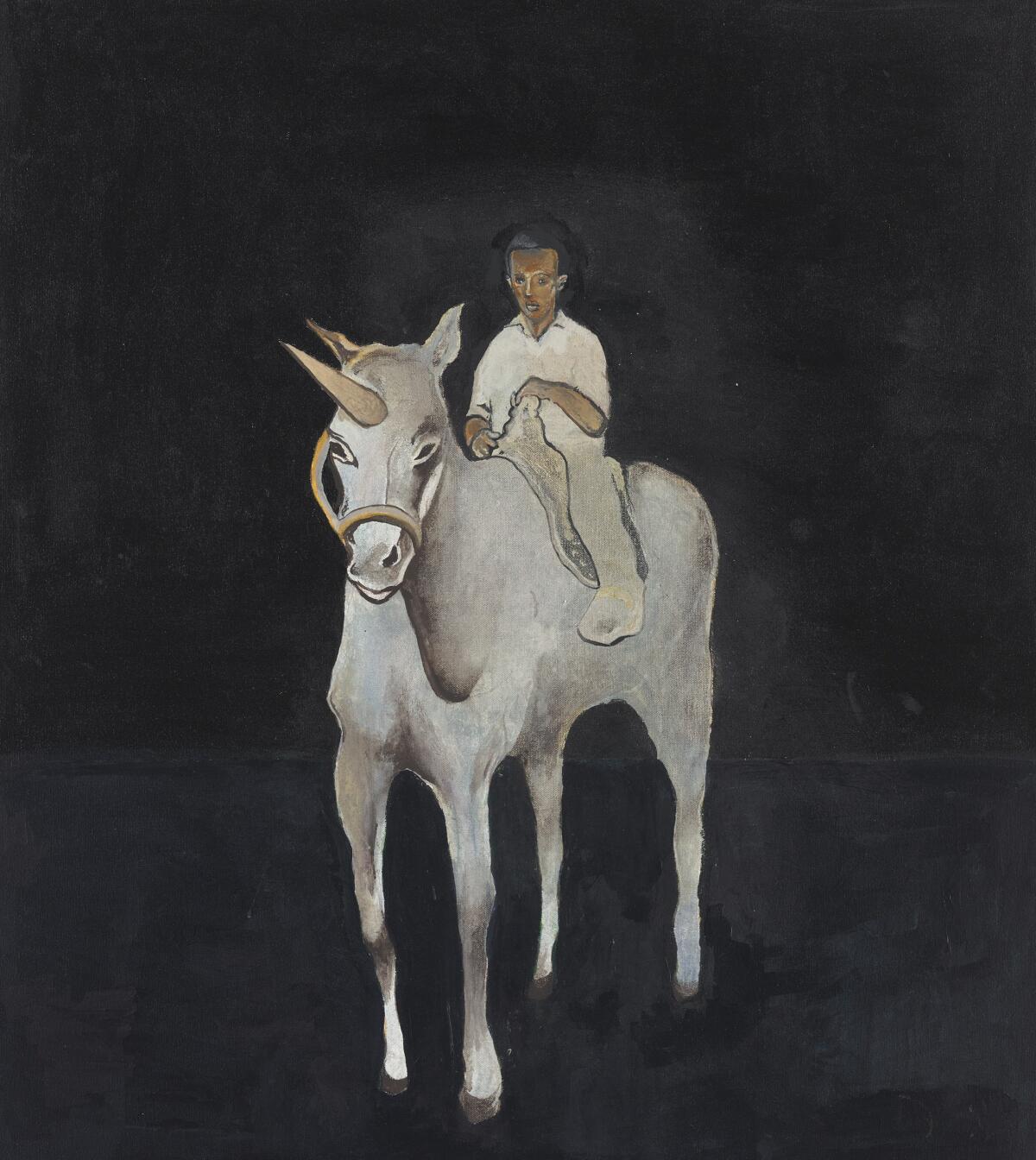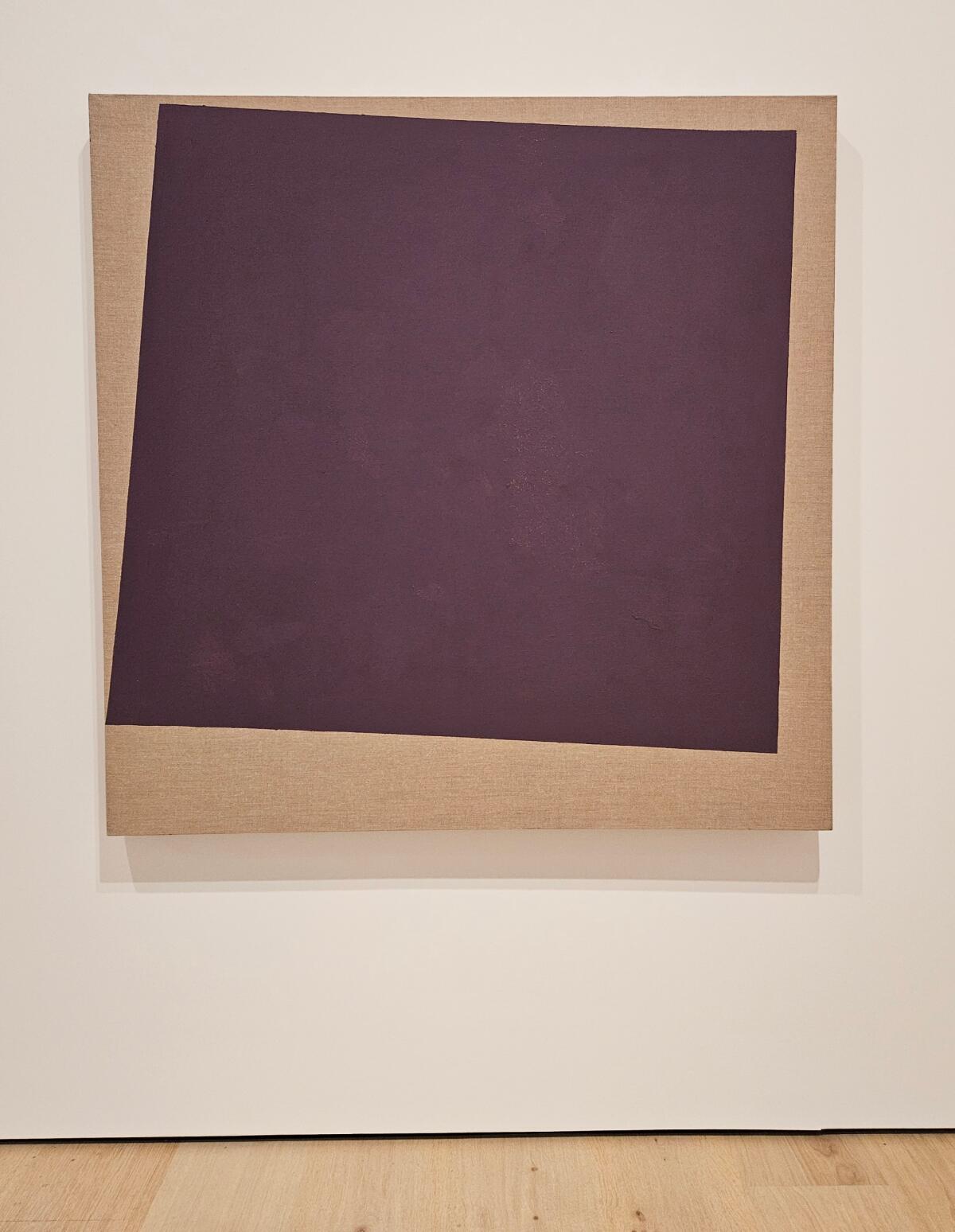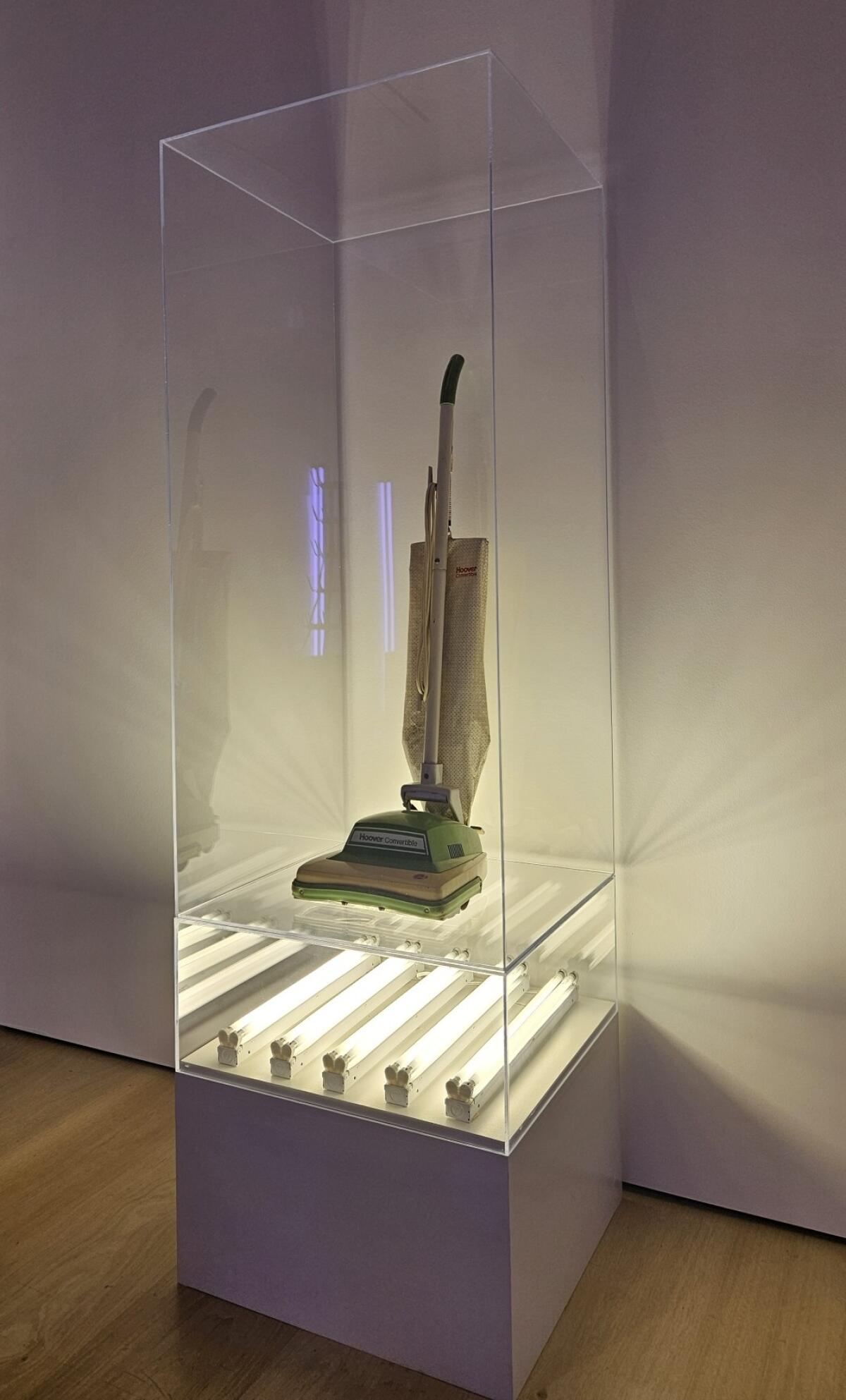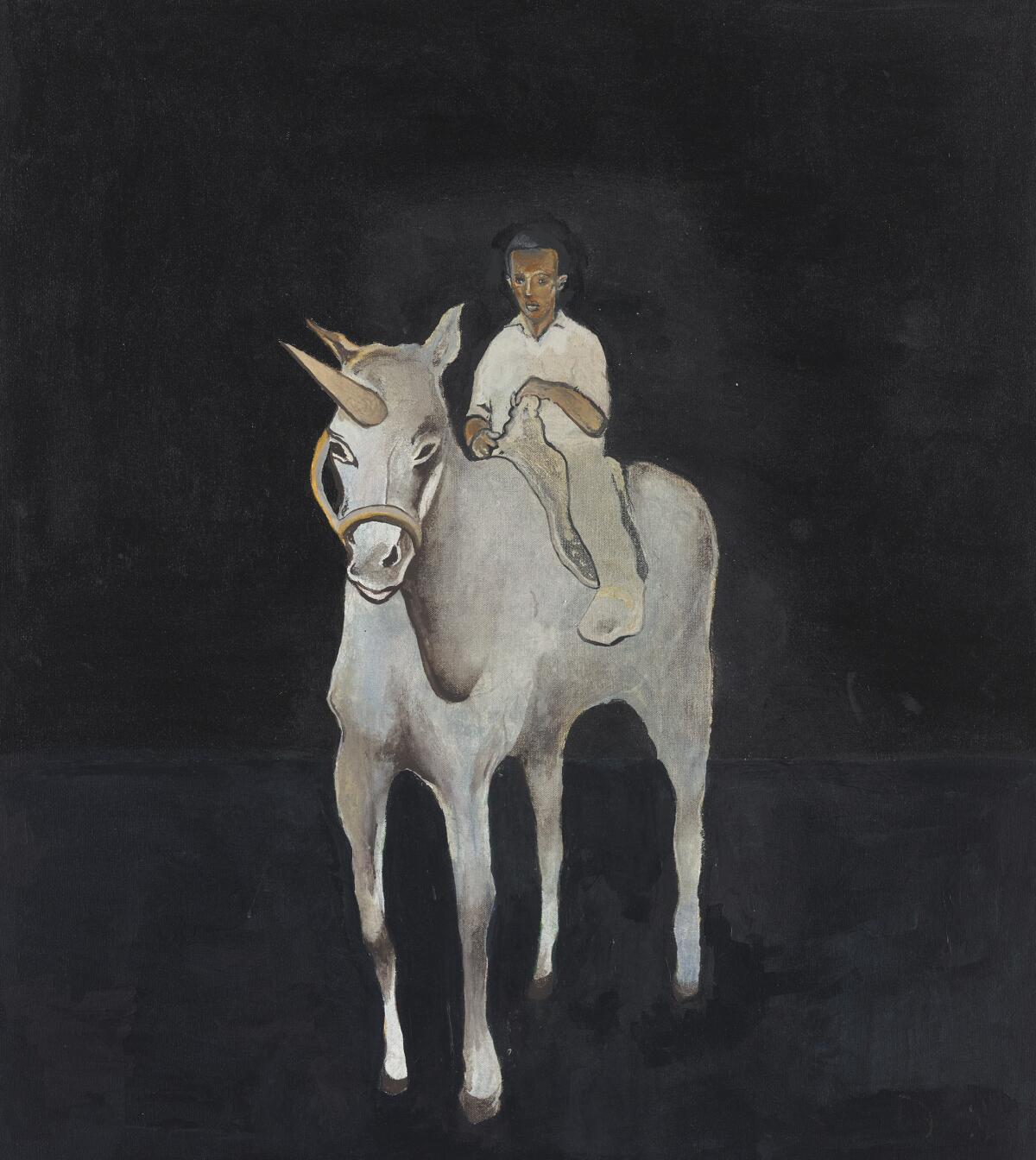The modest but pungent survey of paintings by Noah Davis at the UCLA Hammer Museum is a welcome event. It goes a long way toward demythologizing the Seattle-born, L.A.-based artist, who was heartbreakingly struck down by a rare liposarcoma cancer in 2015, when he was barely 32.
The show affirms his gift for what it was: Davis was a painter’s painter, a deeply thoughtful and idiosyncratic Black voice heard by other artists and aficionados, even as his work was in invigorating development. Talented artists often come into a steadily mature expression in their 30s, the moment when Davis’ accelerating growth was brutally interrupted. The show’s three dozen paintings are understandably uneven, but when Davis was good, he was very good indeed.
That intriguing capacity resonates in the first picture, “40 Acres and a Unicorn,” which hangs alone in the show’s entry to mark the start of his career. Davis was 24 and had studied at Cooper Union in New York and the artist-run Mountain School of Arts in L.A.’s Chinatown. The 2007 painting is not large — 2½ feet tall and slightly narrower — but it casts a spell.
In Western art, a man on a horse is a classic format representing a hero, but here Davis sits a young Black man astride a mythic unicorn — notably white — its buttery beige horn shining amid the painting’s otherwise neutral palette. It’s easy to see the youth as signifying the artist, and the replacement for an art-historical horse likewise standing in for a mule. That animal was famously promised to thousands of formerly enslaved people near the end of the Civil War, along with 40 acres of Confederate land on which they had worked, uncompensated and abused, making the white planter class rich.

Noah Davis, “40 Acres and a Unicorn,” 2007, acrylic and gouache on canvas
(Anna Arca)
The 1865 pledge to redistribute confiscated lands as restitution to African Americans for their enslavement didn’t last a year before being annulled — reparations as rare, unique and desirable as a unicorn, offered by an untrustworthy white ruling class. (Had the 1865 redistribution happened, imagine where we might be today, as racist cruelties initiated by the federal government are running rampant.) Davis, placing his at least symbolic self on the unicorn’s back, plainly asserts his social and cultural confidence. Art is imagination made real, and as a Black American artist, he’s going to ride it forward.
Perhaps the canvas’ most beautiful feature is the rich skin of black acrylic paint within which he and his steed, both rendered in soft veils of thin gouache, are embedded. The luminous black abstraction dominating the surface was visibly painted after the figures, which feel like they are being held in its embrace.
Thirty-nine paintings on canvas and 21 on paper are installed chronologically, the works on paper selected from 70 made during Davis’ lengthy hospitalization. The layering of topicality, color sensitivity, art-historical ancestors and figuration and abstraction in “40 Acres and a Unicorn” recurs throughout the brief eight-year period being surveyed. (The traveling show was organized by London’s Barbican Art Gallery with Das Minsk, an exhibition hall in Potsdam, Germany.) The most abstract painting is on a wall by itself in the next room, and it demonstrates Davis’ unusual exploratory strategies.
Titled “Nobody,” a four-sided geometric shape is rendered in flat purple house paint on linen, 5 feet square. The layered difference in materials — an image built from practical, domestic paint on a refined and artistic support — is notable. The irregular shape, however two-dimensional, seems to hover and tilt in dynamic space. It suggests a 2008 riff on the long, rich legacy of Kazimir Malevich’s radical, revolutionary geometric abstractions from 1915.

Noah Davis, “Nobody,” 2008, house paint on linen
(Christopher Knight / Los Angeles)
The reference to the Russian avant-garde recalls that Malevich’s art was dubbed Suprematism, which bumped aside the academic hierarchy of aesthetic rules in favor of “the supremacy of pure artistic feeling,” most famously represented as a painted black square. Here, it twists into an inevitable jab at an ostensibly liberal Modern art world, still in fact dominated by unexamined white supremacy.
“Nobody” weaves together art and social history in surprising ways. It’s one of three geometric abstractions Davis made, their shapes based on the map contour of a battleground state in the revolutionary election year that brought Barack Obama to the presidency.
Colorado, a state whose shape is a simple rectangle, flipped from George W. Bush in 2004, while the secondary color of Davis’ choice of purple paint was created by combining two primary pigments — red and blue. The color purple also carries its own recognizable, resonant reference, embedded in popular consciousness for Alice Walker’s often-banned Pulitzer Prize-winning novel and Steven Spielberg’s hit movie of the book, a record holder of dubious distinction, tied for the most Oscar nominations (11) without a single win. Davis’ torqued purple rectangle looks to be in mid-flip.
That Davis exhibited but ultimately painted over the other two works in his geometric series might suggest some dissatisfaction with their admittedly obscure nature. (“Nobody” almost requires footnotes.) He returned to painting the figure — “somebody” — but often embedded it in visually sumptuous abstract fields. The hedge behind “Mary Jane,” a young girl in a striped pinafore, visually a cousin to the little girl engulfed in billowing locomotive steam clouds in Édouard Manet’s “The Railway,” is a gorgeously writhing arena of spectral green, gray and black forms.

Noah Davis, “Mary Jane,” 2008, oil and acrylic on canvas
(Kerry McFate)
So is the forest of “The Missing Link 6,” where a hunter with a rifle sits quietly at the base of a massive tree trunk, virtually secreted in the landscape, like something rustling in the dense foliage in a Gustave Courbet forest. The missing-link title declares Davis’ intention to join an evolutionary chain of artists, the hidden hunter adding an element of surprise.
Art history is threaded throughout Davis’ work. (He spent productive research time working as an employee at Art Catalogues, the late Dagny Corcoran’s celebrated bookstore, when it was at MOCA’s Pacific Design Center location.) The tension between established and new art, which seeks to simultaneously acknowledge greatness in the past while overturning its rank deficiencies, is often palpable. Nowhere is the pressure felt more emphatically than in the knockout “1975 (8),” where joyful exuberance enters the picture, as folks cavort in a swimming pool.
The subject — bathers — is as foundational to Modern art as it gets, conjuring Paul Cézanne. Meanwhile, the swimming pool is quintessentially identified with Los Angeles. (Another fine pool painting, “The Missing Link 4,” has a Modernist Detroit building as backdrop, painted as a grid of color rectangles reminiscent of a David Hockney, an Ed Ruscha or a Mark Bradford.) Bathers are an artistic signal for life crawling onto shore out of the primordial ooze or basking in a pastoral, prelapsarian paradise.
For America, the swimming pool is also an archetypal segregationist site of historical cruelty and exclusion. Davis seized the contradiction.
Draining public swimming pools to avoid integration in the wake of civil rights advances happened in countless places. It showed the self-lacerating depth to which irrational hate can descend, as policy advocate Heather McGhee wrote in her exceptional book, “The Sum of Us: What Racism Costs Everyone and How We Can Prosper Together.” People were willing to harm everyone in a community by dismantling a popular public amenity rather than accept full equality. In “1975 (8),” the title’s date is within just a few years of the Supreme Court’s appalling ruling in Palmer vs. Thompson, which gave official blessing to the callous practice McGhee chronicled.

Noah Davis, “The Missing Link 4,” 2013, oil on canvas
(Robert Wedemeyer)
The 2013 painting’s composition is based on a photograph taken by Davis’ mother four decades earlier. A bright blue horizontal band in an urban landscape is dotted with calmly bobbing heads. A leaping male diver seen from behind dominates the lower foreground, angled toward the water. The soles of his bare feet greet our eyes, lining us up behind him as next to plunge in.
Davis suspends the aerial diver in space, a repoussoir figure designed to visually lead us into the scene. Like the unicorn rider, he assumes the artist’s metaphorical profile. A moment of anticipatory transition is frozen, made perpetual. Waiting our turn, we’re left to contemplate the soles of his feet — a familiar symbol of path-following humility, whether in Andrea Mantegna’s Italian Renaissance painting of a “Dead Christ” or countless Asian sculptures of Buddha.
The marvelous painting was made at a pivotal moment. A year before, Davis and his wife, sculptor Karon Davis, joined four storefronts on Washington Boulevard in Arlington Heights to create the Underground Museum. Their aim was to create a self-described family-run cultural space in a Black and Latino neighborhood. (Money came from an inheritance from his recently deceased father, with whom Davis was close.) A year later, the ambitious startup expanded when the project took on the internationally acclaimed Museum of Contemporary Art as an organizing partner. One room in the show includes mock-ups of classic sculptures — imitations — by Marcel Duchamp, Dan Flavin, Robert Smithson and Jeff Koons, which Davis made for an exhibition to reference the classic 1959 Douglas Sirk movie about racial identity, “Imitation of Life.” The appropriations ricochet off the feminist imitations of Andy Warhol and Frank Stella paintings that Elaine Sturtevant began to make in the 1960s.
Not all of Davis’ paintings succeed, which is to be expected of his youthful and experimental focus. An ambitious group that references raucous daytime TV talk programs from the likes of Maury Povich and Jerry Springer, for example, tries to wrestle with their trashy exploitation of identity issues as entertainment — DNA paternity tests and all. But a glimpse of “Maury” with a crisp Mondrian painting hanging in the background just falls flat. The juxtaposition of popular art’s messy vulgarity with the pristine aspirations of high art is surprisingly uninvolving.
Still, most of the exhibition rewards close attention. It handily does what a museum retrospective should do, securing the artist’s reputation. At any rate it’s just a sliver of some 400 paintings, sculptures and drawings the artist reportedly made. Whatever else might turn up in the future, the current selection at the Hammer represents the brilliant early start of Davis’ abbreviated career. Forget the mythology; the show’s reality is better.

Noah Davis, “Imitation of Jeff Koons,” 2013, mixed media
(Christopher Knight / Los Angeles Times)
‘Noah Davis’
Where: UCLA Hammer Museum, 10899 Wilshire Blvd., Westwood
When: Through Aug. 31. Closed Monday.
Info: (310) 443-7000, hammer.ucla.edu
